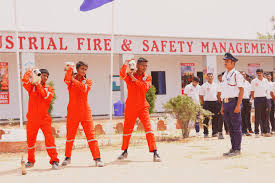
CERTIFICATE IN FIRE ENGINEERING AND SAFETY MANAGEMENT (1YEAR)
📚 COURSE STRUCTURE
1. Introduction to Fire Engineering and Safety
- Scope and importance of fire engineering
- Structure of fire and rescue services
- Roles and responsibilities of safety personnel
- Overview of major fire disasters and their lessons
2. Basics of Fire Science
- Fire triangle and fire tetrahedron
- Types and classes of fire (A, B, C, D, K)
- Stages of fire development
- Fire behavior and spread mechanisms
3. Fire Detection and Protection Systems
- Fire detectors: smoke, heat, flame
- Alarm systems and control panels
- Sprinkler systems (wet, dry, deluge)
- Fire hydrants and hose reels
- Gas suppression systems (CO₂, FM-200)
4. Portable Fire Extinguishers
- Types of extinguishers (Water, CO₂, DCP, Foam, Clean Agent)
- Selection and correct use
- Maintenance and refilling procedures
- Hands-on practice with extinguishers
5. Industrial and Workplace Safety
- Identifying fire hazards at the workplace
- Safe handling of flammable materials
- Electrical fire safety
- Storage safety and housekeeping
6. Safety Management Principles
- Introduction to occupational health and safety (OHS)
- Risk assessment and hazard identification
- Use of Personal Protective Equipment (PPE)
- Safety signage and communication
7. First Aid and Emergency Response
- CPR and artificial respiration
- Burn management and fracture care
- Emergency evacuation procedures
- Mock drills and rescue planning
8. Legislation & Fire Safety Codes (Basics)
- Local fire laws and building codes
- Overview of National Building Code (NBC – India, or local equivalent)
- OSHA basics and workplace compliance
- Fire safety responsibilities of employers/employees
9. Practical Training / Fire Drill
- Fire drill simulations
- Hose handling and hydrant use
- Fire extinguisher practice
- Rescue and stretcher handling
- Visit to a fire station or industrial site (recommended)

